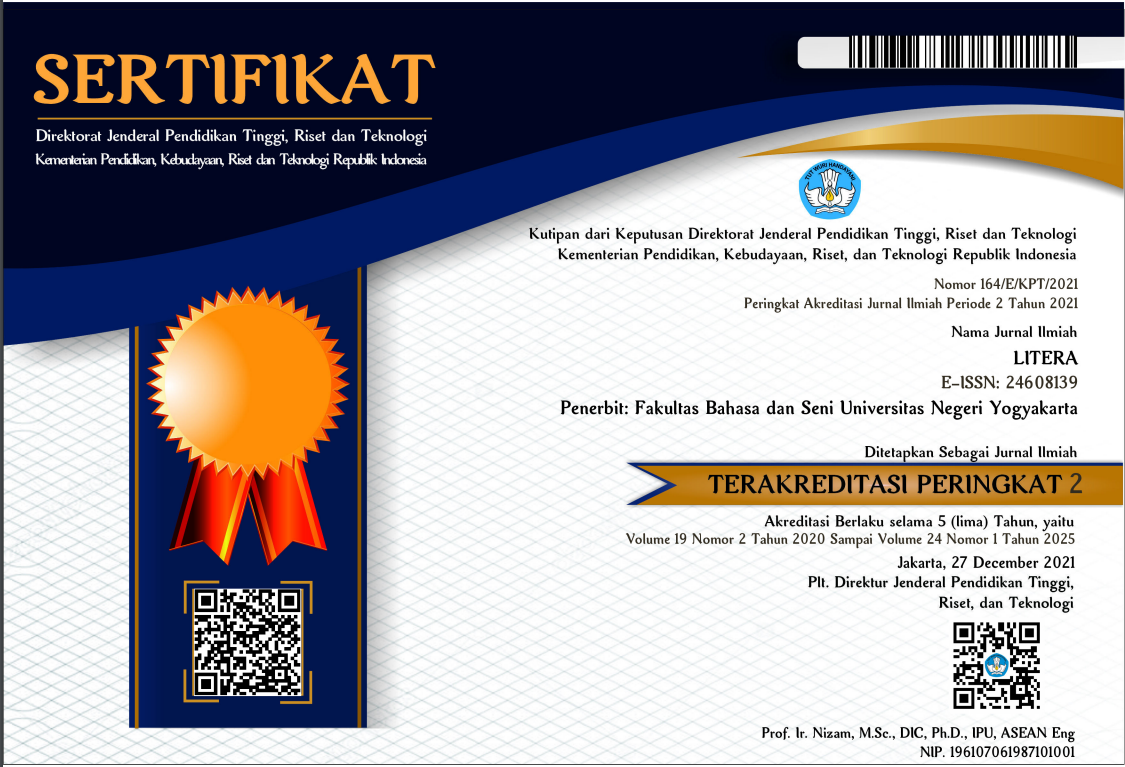MODIFIED CHILD-DIRECTED SPEECH (MCDS) AND THE USE OF A NAMING TASK TO COMPARE THE PACING OF LANGUAGE ACQUISITION AND VOCABULARY BUILDING OF AGE 2-6 LEARNERS OF THEFIRST AND SECOND LANGUAGES
Abstract
As support to several studies about Child-Directed Speech (CDS), also known as motherese or parentese, this study compared the pacing of three children learning their first and second languages (Filipino and English) and explored the language learning of children exposed to aspecialized language task specific to the vocabulary building and facilitated through a style derived from CDS while listening to the oral drills and language reviews done by the mother and the other siblings at home. The respondents were of different ages (i.e. 2, 4, and 6 years old) and varied interms of language input and output due to differences in exposure and environment (i.e. schooling and non-schooling). Furthermore, the study used a specially-designed framework explaining the totality of the process, actions taken to address difficulties, and corrected output or acquired vocabulary through interaction and exposure. Exposure to language input was tested in the assessment phase. The study also tested the ability of the youngest child not yet studying in a formal school, unlike his siblings, to absorb language input, still, with constant exposure (in the corrective phase) leading to success in correction of difficulties and acquisition of language input.
Keywords: Modified Child Directed Speech, exposure, uncorrected output, corrected output
MODIFIED CHILD-DIRECTED SPEECH (MCDS) DAN PENGGUNAAN TUGAS PENAMAAN UNTUK MEMBANDINGKAN KECEPATAN PEMEROLEHAN BAHASA DAN PENGEMBANGAN KOSAKATA PEMBELAJAR BAHASA PERTAMA DAN KEDUA USIA 2-6 TAHUN
Abstrak
Untuk mendukung beberapa penelitian tentang Child-Directed Speech(CDS), juga dikenal sebagai bahasa ibu atau orang tua, penelitian ini membandingkan kecepatan tiga anak yang mempelajari bahasa pertama dan kedua (bahasa Filipina dan Inggris) dan mengeksplorasi pembelajaran bahasa anak-anak yang dipajankan pada tugas kebahasaan khusus terutama untuk mengembangkan kosakata dan difasilitasi melalui gaya yang berasal dari CDS sambil mendengarkan latihan lisan dan penjelasan yang dilakukan oleh ibu dan saudara lainnya di rumah. Responden berbeda usia (yaitu 2, 4, dan 6 tahun) dan bervariasi dalam hal input dan output bahasa karena perbedaan dalam pajanan dan lingkungan (yaitu sekolah dan non-sekolah). Selanjutnya, penelitian ini menggunakan kerangka yang dirancang khusus yang menjelaskan totalitas proses, tindakan yang diambil untuk mengatasi kesulitan, dan mengoreksi luaran atau memperoleh kosakata melalui interaksi dan pajanan. Pajanan masukan bahasa diuji dalam fase penilaian. Penelitian ini juga menguji kemampuan anak bungsu yang belum belajar di sekolah formal, tidak seperti saudara kandungnya, untuk menyerap input bahasadengan pajanan yang terus menerus (dalam fase korektif) yang mengarah pada keberhasilan dalam koreksi kesulitan dan perolehan input bahasa.
Kata kunci: Modified Child-Directed Speech, pajanan, luaran tidak terkoreksi, luaran terkoreksi
Full Text:
PDFReferences
[1] Cranium Cariboo. (2016). Retrieved from http://craftulate.com/ product/noun-sight-word-cards-for-cariboo
[2] Fernald, A. (1985). Four-Month Old Infants Prefer to Listen to Motherese. Infant and Behavior Development8,181-195.
[3] Gass, S. M. & Selinker, L. (2008). Second Language Acquisition: an Introductory Course. In S. M. Gass & L. Selinker (Eds.), An Integrated View of Second Language Acquisition (pp.479-504) New York and London: Routledge.
[4] Höhle, B. (2009). Cross linguistic perspective son segmentation and categorization in early language acquisition. The Cambridge Handbook of Child Language. In E.L.
[5] Bavin (Ed.), (pp. 125-144). United States of America: Cambridge University Press.
[6] Lust, B. (2006). The nature of nurture. In B. Lust (Ed.), Child Language: Acquisition and Growth (p.121). New York: Cambridge University Press.
[7] Newman, R. & Sachs, J. (2013). Communication Development in Infancy. The Development of Language 8th Ed. In Gleason, J.B. & Ratner, N.B. (Ed.). (pp. 30-51). United States of America: Pearson Education, Inc.
[8] Stoll, S. (2009). Crosslinguistic approaches to language acquisition. In E.L. Bavin (Ed.), The Cambridge Handbook of Child Language (p.98). New York: Cambridge University Press.
[9] Student Coalition for Action on Literacy Education (2014). Behavior Management Important Facts. Retrieved from http://readwriteact. o r g / f i l e s / 2 0 1 4 / 0 7 / B e h a viorManagement-ImportantFacts.pdf
[10] Tarone, E. (2007). Sociolinguistic Approaches to Second Language Acquisition Research—1997-2007. The Modern Language Journal, 91, Focus Issue, 844.
[11] What is “Cranium Cariboo”? (2016). Retrieved from https:// www.reference.com/hobbies-g a m e s / c r a n i u m - c a r i b o o - e145e11b7ee6b04c#
DOI: https://doi.org/10.21831/ltr.v17i2.20557
Refbacks
- There are currently no refbacks.
______________________
__________________________________________________________________________________________________
Litera Journal is published by the Faculty of Languages, Arts, and Culture Universitas Negeri Yogyakarta in collaboration with Himpunan Sarjana Kesusasteraan Indonesia (HISKI)
The International Journal of Linguistic, Literature, and Its Teaching at http://http://journal.uny.ac.id/index.php/litera/ is licensed under a Creative Commons Attribution-ShareAlike 4.0 International License
__________________________________________________________________________________________________















